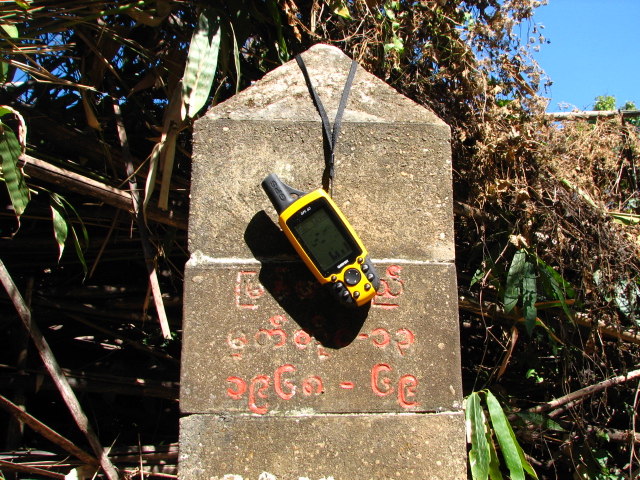Tokalo : Day Ten
Day Ten is about looking with awe
at both – hornbills and colleagues.
We wake up peacefully knowing that we don’t have
to move to another camp today. After tea, as I lay lazily, I see 7 oriental
pied hornbills fly over our camp. Breath stopping – if that is the term. I
finally am clear with the difference in their tail markings vis-à-vis the great
Indian hornbills. Together they did not make that walk-stopping sound the great
Indian hornbill made the other day.
Border Pillar garlanded with a GPS
I have a locally made knife (dao) with me; big
one (13 inches, I measured yesterday). It is bigger than those used in Western
Classics and heavy by even Mizo standards. I, with immense pride, use it to cut
2 big branches that appear in our route. A little ahead as I strike a 3rd
big branch, with what I feel is style, I get hit with a bang on my head. It is
the other end of the branch. 6 years and little more of life at Sheopur, South
Garo Hills and now Saiha
are insufficient to learn of the forest and village ways of life. To unlearn my
urban upbringing! Repeatedly this trip has brought this forth.
As we walk after food we hear hoolock gibbons about
500 mtrs from the camp. I take notes and plan to check up more on their home
range once back. Colleagues also hear the barking deer and I see a civet scampering
- around noon time!
How and where to move
We reach Border Pillar 13 and Border Pillar 14.
Put up during 1968 -69 these small structures are big landmarks in the area. We
put up final post of the day, number 28, corresponding to Border Pillar 14. How
Ra manages to find these posts is a mystery to me!
I talk to NT about the hunting related talk of
the previous evening; he takes form of the laughing Buddha and says “Eesh I told them we don’t like monkeys!”
Welcome to the forest department of MADC that governs one of the better
remaining rain-forest's in this part of the country!
We again have fish today and I wonder how they
manage to get them in the scanty water around. I saw them going to the pool in
the stream with 2 aluminium plates. Today I am also told of how people post harvest
leave domestic pigs in their jhum fields. These are baits. When the wild pigs
arrive to mate with these they are shot from a close range. We also see traps
as we move today. These, I am told, are put up by the Burmese. I smile. Gujarat
problems attributed to Pakistan, Assam problems to Bangladesh and here for a
trap that was possibly meant to catch a barking deer we happily pass on the
blame to Burma.
When the sun made us happy
Today I lose my specs like a fool and like a
bigger fool have a couple of colleagues help in look out for them;
unsuccessfully. The good point is I will be less fussy while using camera and
binoculars.
I realize how difficult it is to walk up a river!
We walk at most times on the river bed – read stones – but we also have to walk
on the sides. Depending on the ease factor it could either be in India or in Burma.
As we come across a fallen tree that we need to cross the river on Jo asks me
if I can do it. From the other end I respond, “never tried so don’t know”. This held true for much of the survey. I
walk on successfully - surprising all present including myself.
Beauty all around
We continue to walk and I go slow, I slip, I
hold trees and am tentative. Colleagues on the other hand take to this path
like hoolock gibbons to branches. The difference of growing up in India’s
erstwhile capital and in southern most corner of Mizoram’s hills is apparent. I can see the question in their eyes “What is so fussy about walking a bit?” In the years to come I will continue to learn
more of this – the value of what absence of resources, security and comfort
teach us!
We are trying to follow the boundary but in this
maze of mazes we are all but sure. This is not just the Wildlife Sanctuary
boundary but also the international boundary.
Just before we go off to sleep NT asks me if we
should put our posts deeper for there stood an impending danger of Burmese
people stealing them and utilizing them for making equipments!
Day Nine here




Comments
Post a Comment